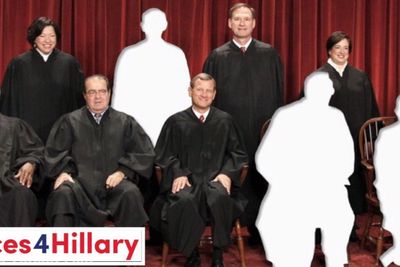The June 27 ruling by the Supreme Court in Whole Woman's Health v. Hellerstedt was a major victory for abortion rights. In striking down Texas's onerous admitting privileges and surgical-center requirements, the Court strengthened the "undue burden" standard of Planned Parenthood v. Casey holding that that standard "requires that courts consider the burden a law poses on abortion access together with the benefits those laws confer." However, allowing the outcome in Whole Woman's Health to lull us into complacency as we consider the choices before us in the presidential election would be a terrible mistake. Without a doubt, the next President will determine the breadth, depth and long-term security of protection for abortion and other reproductive rights.
Through her appointments to the Supreme Court and the lower federal courts, her executive orders and enforcement of existing laws, budgetary priorities and legislative initiatives Hillary Clinton will solidify and expand protections for these rights.
First, the next president will have the opportunity to shape the composition of the Supreme Court and the lower federal courts for decades. Replacing Justice Scalia is only the beginning.
While (contrary to Donald Trump's inaccurate assertions) Scalia's vote would not have made a difference in the 5-3 outcome in Whole Woman's Health, it's likely that several members of that 5-member majority will step down from the Court in the next several years.
Ruth Bader Ginsburg, Anthony Kennedy and Stephen Breyer (who wrote the majority opinion in Whole Woman's Health) will turn 84, 81 and 79 respectively in 2017. Replacing these justices with others who will provide robust protection for abortion rights is critically important.
Moreover, while resolving the fate of the Texas law, the ruling in Whole Woman's Health relied heavily on the factual record before it and did not definitively resolve the fate of similar laws in other states or a plethora of other anti-choice laws on the books such as those requiring medically unnecessary ultrasounds or those that ban abortions at 20 weeks. While laws like those in Texas are unlikely to survive after Whole Woman's Health, all of these challenges will be fought in the lower federal courts and judges in these courts will initially decide the fate of these restrictions. Hillary Clinton will appoint judges who will vigorously protect abortion rights to these key positions in the lower federal courts.
Second, the next President can either strengthen or eviscerate existing federal laws that impact reproductive rights. The Obama administration's enforcement of the Affordable Care Act to ensure no-cost coverage of contraceptives and its efforts to protect Medicaid patients by sending warning notices last April to states that halted Medicaid funding to Planned Parenthood affiliates because they offer abortions are just two recent examples of the power of the President to protect reproductive rights.
A Hillary Clinton administration will aggressively enforce existing laws so as to ensure strong protection for reproductive rights. She will also oppose Republican efforts to defund Planned Parenthood and vigorously defend and strengthen the Affordable Care Act and its many protections for women's reproductive health care.
Finally, a Hillary Clinton presidency offers the possibility of even more expansive reforms in this area. She has called for the repeal of the Hyde Amendment, which bars the use of federal funds (including Medicaid) for paying for most abortions, and the repeal or, minimally, an expansive reinterpretation of the Helms Amendment, a long-standing restriction which bans the use of foreign aid to pay for abortion "as a method of family planning." Importantly, the proposed Democratic platform explicitly called for the repeal of both the Hyde Amendment and the Helms Amendment.
In short, it's impossible to overstate what Hillary's election means for the reproductive rights. Spread the word.
###
September 3, 2016
